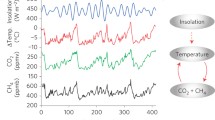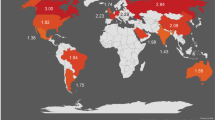Abstract
We test for causality between radiative forcing and temperature using multivariate time series models and Granger causality tests that are robust to the non-stationary (trending) nature of global climate data. We find that both natural and anthropogenic forcings cause temperature change and also that temperature causes greenhouse gas concentration changes. Although the effects of greenhouse gases and volcanic forcing are robust across model specifications, we cannot detect any effect of black carbon on temperature, the effect of changes in solar irradiance is weak, and the effect of anthropogenic sulfate aerosols may be only around half that usually attributed to them.


Similar content being viewed by others
Notes
Here and in the remainder of the paper we use “cause” for “Granger cause” to make the paper more readable.
Jacobs et al. (1979) propose a structural vector autoregression model where there are also simultaneous or instantanteous interactions among the variables. They list three different hypotheses about the causality between variables x and y. In the context of their hypotheses, non-rejection of the null hypothesis of non-casuality from x to y in our equation (2) could be because there are neither instantaneous nor lagged effects of x on y – their H1. But shocks to x in previous periods affect the current of value of y through both the direct effect of the lagged value of x on y and through their effect on the current value of x and it is possible that these two effects exactly cancel so that past values of x do not improve forecasts of y—their H3. They argue that non-rejection of the null of no Granger causality does not mean that there is no actual causality. This situation is rather unlikely (Sargent 1979). Note, that if there are only instantaneous effects in their structural model, past values of x will be useful in predicting y.
The main difference between the analysis in Table 7 in Triacca et al. (2013) and our analysis is that they do not control for anthropogenic aerosols.
References
Attanasio A (2012) Testing for linear Granger causality from natural/anthropogenic forcings to global temperature anomalies. Theor Appl Climatol 110:281–289
Attanasio A, Pasini A, Triacca U (2012) A contribution to attribution of recent global warming by out-of-sample Granger causality analysis. Atmos Sci Lett 13(1):67–72
Barichivich J, Briffa KR, Osborn TJ, Melvin TM, Caesar J (2012) Thermal growing season and timing of biospheric carbon uptake across the Northern Hemisphere. Glob Biogeochem Cycles 26(4), GB4015
Beenstock M, Reingewertz Y, Paldor N (2012) Polynomial cointegration tests of anthropogenic impact on global warming. Earth Syst Dyn 3:173–188
Bilancia M, Vitale D (2012) Anthropogenic CO2 emissions and global warming: evidence from Granger causality analysis. In: Di Ciaccio A, Coli M, Angulo Ibanez JM (eds.) Advanced statistical methods for the analysis of large data-sets, Springer, pp 229–239
Bond TC et al (2013) Bounding the role of black carbon in the climate system: a scientific assessment. J Geophys Res-Atmos 118(11):5380–5552
Boucher O, Pham M (2002) History of sulfate aerosol radiative forcings. Geophys Res Lett 29(9):22-1–22-4
Canty T, Mascioli NR, Smarte M, Salawich RJ (2012) An empirical model of global climate—Part 1: reduced impact of volcanoes upon consideration of ocean circulation. Atmos Chem Phys Discuss 12:23829–23911
Compo GP, Sardeshmukh PD (2010) Removing ENSO-related variations from the climate record. J Clim 23:1957–1978
Forster P, Ramaswamy V, Artaxo P, Berntsen T, Betts R, Fahey DW, Haywood J, Lean J, Lowe DC, Myhre G, Nganga J, Prinn R, Raga G, Schulz M, Van Dorland R (2007) Changes in atmospheric constituents and in radiative forcing. In: Solomon S, Qin D, Manning M, Chen Z, Marquis M, Averyt KB, Tignor M, Miller HL (eds.) Climate change 2007: The physical science basis, Contribution of Working Group I to the Fourth Assessment Report of the Intergovernmental Panel on Climate Change, Cambridge University Press, 129–234
Granger CWJ (1988) Some recent developments in a concept of causality. J Econ 39:199–211
Hacker RS, Hatemi-J A (2006) Tests for causality between integrated variables using asymptotic and bootstrap distributions: theory and application. Appl Econ 38(13):1489–1500
Hansen J, Ruedy R, Sato N, Lo K (2010) Global surface temperature change. Rev Geophys 48, RG4004
Jacobs RL, Leamer EE, Ward MP (1979) Difficulties with testing for causation. Econ Inq 17(3):401–413
Kaufmann RK, Juselius K (2013) Testing hypotheses about glacial cycles against the observational record. Paleoceanography 28(1):175–184
Kaufmann RK, Kauppi H, Stock JH (2006) Emissions, concentrations, and temperature: a time series analysis. Clim Chang 77(3–4):249–278
Kaufmann RK, Kauppi H, Mann ML, Stock JH (2013) Does temperature contain a stochastic trend: linking statistical results to physical mechanisms. Clim Chang 118(3–4):729–743
Kaufmann RK, Kauppi H, Mann ML, Stock JH (2011) Reconciling anthropogenic climate change with observed temperature 1998–2008. Proc Natl Acad Sci 108(29):11790–11793
Kaufmann RK, Stern DI (1997) Evidence for human influence on climate from hemispheric temperature relations. Nature 388:39–44
Keeling CD, Piper SC, Bacastow RB, Wahlen M, Whorf TP, Heimann M, Meijer HA (2005) Atmospheric CO2 and 13CO2 exchange with the terrestrial biosphere and oceans from 1978 to 2000: Observation and carbon cycle implications. In: Ehleringer JR, Cerling T, Dearing MD (eds.) A history of atmospheric CO2 and its effects on plants, animals, and ecosystems. Ecological Studies 177, Springer, pp 83–113
Klimont Z, Smith SJ, Cofala J (2013) The last decade of global anthropogenic sulfur dioxide: 2000–2011 emissions. Environ Res Lett 8:014003
Kodra E, Chatterjee S, Ganguly AR (2011) Exploring Granger causality between global average observed time series of carbon dioxide and temperature. Theor Appl Climatol 104(3–4):325–335
Lean JL, Rind DH (2008) How natural and anthropogenic influences alter global and regional surface temperatures: 1889 to 2006. Geophys Res Lett 35, L18701
Levitus S, Antonov JI, Boyer TP, Baranova OK, Garcia HE, Locarnini RA, Mishonov AV, Reagan JR, Seidov D, Yarosh ES, Zweng MM (2012) World ocean heat content and thermosteric sea level change (0–2000 m), 1955–2010. Geophys Res Lett 39(10), L10603
Lütkepohl H (1982) Non-causality due to omitted variables. J Econ 19:367–378
Mascioli NR, Canty T, Salawitch RJ (2012) An empirical model of global climate—Part 2: implications for future temperature. Atmos Chem Phys Discuss 12:23913–23974
Meinshausen M, Smith S et al (2011) The RCP GHG concentrations and their extension from 1765 to 2300. Clim Chang 109:213–241
Morice CP, Kennedy JJ, Rayner NA, Jones PD (2012) Quantifying uncertainties in global and regional temperature change using an ensemble of observational estimates: the HadCRUT4 dataset. J Geophys Res 117, D08101
Parrenin F, Masson-Delmotte V, Kohler P, Raynaud D, Paillard D, Schwander J, Barbante C, Landis A, Wegner A, Jouzel J (2013) Synchronous change of atmospheric CO2 and Antarctic temperature during the last deglacial warming. Science 330:1060–1063
Piao S, Ciais P, Friedlingstein P, Peylin P, Reichstein M, Luyssaert S, Margolis H, Fang J, Barr A, Chen A, Grelle A, Hollinger DY, Laurila T, Lindroth A, Richardson AD, Vesala T (2008) Net carbon dioxide losses of northern ecosystems in response to autumn warming. Nature 451(7174):49–53
Pasini A, Triacca U, Attanasio A (2012) Evidence of recent casual decoupling between solar radiation and global temperature. Environ Res Lett 7:034020
Sargent TJ (1979) Causality, exogeneity, and natural rate models: reply to C. R. Nelson and B. T. McCallum. J Political Econ 87(2):403–409
Sato M, Hansen JE, McCormick MP, Pollack JB (1993) Stratospheric aerosol optical depth, 1850–1990. J Geophys Res 98(D12):22987–22994
Schwarz GE (1978) Estimating the dimension of a model. Ann Stat 6(2):461–464
Shakun JD, Clark PU, He F, Marcott SA, Mix AC, Liu Z, Otto-Bliesner B, Schmittner A, Bard E (2012) Global warming preceded by increasing carbon dioxide concentrations during the last deglaciation. Nature 484:49–55
Smith SJ, van Aardenne J, Klimont Z, Andres RJ, Volke A, Delgado Arias S (2011) Anthropogenic sulfur dioxide emissions: 1850–2005. Atmos Chem Phys 11:1101–1116
Stern DI (2006) An atmosphere–ocean multicointegration model of global climate change. Computat Stat Data Anal 51(2):1330–1346
Stern DI, Kaufmann RK (2000) Detecting a global warming signal in hemispheric temperature series: a structural time series analysis. Clim Chang 47:411–438
Stone DA, Allen MR, Stott PA, Pall P, Min S-K, Nozawa T, Yukimoto S (2009) The detection and attribution of human influence on climate. Annu Rev Environ Resour 34:1–16
Stone DA, Allen MR (2005) Attribution of global surface warming without dynamical models. Geophys Res Lett 32, L18711
Sugihara G, May R, Ye H, Hsieh C-H, Deyle E, Fogarty M, Munch S (2012) Detecting causality in complex ecosystems. Science 338:496–500
Toda HY, Phillips PCB (1993) The spurious effect of unit roots on vector autoregressions: an analytical study. J Econ 59:229–255
Toda HY, Yamamoto T (1995) Statistical inference in vector autoregressions with possibly integrated processes. J Econ 66:225–250
Triacca U (2001) On the use of Granger causality to investigate the human influence on climate. Theor Appl Climatol 69:137–138
Triacca U (2005) Is Granger causality analysis appropriate to investigate the relationship between atmospheric concentration of carbon dioxide and global surface air temperature? Theor Appl Climatol 81(3–4):133–135
Triacca U, Attanasio A, Pasini A (2013) Anthropogenic global warming hypothesis: testing its robustness by Granger causality analysis. Environmetrics 24(4):260–268
Tung K-K, Zhou J (2013) Using data to attribute episodes of warming and cooling in instrumental records. Proc Natl Acad Sci 110(6):2058–2063
Wigley TML, Raper SCB (1992) Implications for climate and sea level of revised IPCC emissions scenarios. Nature 357:293–300
Wilde J (2012) Effects of simultaneity on testing Granger-causality—a cautionary note about statistical problems and economic misinterpretations. Institute of Empirical Economic Research, University of Osnabrück, Working Paper 93
Acknowledgments
We thank Paul Burke, Robert Costanza, Zsuzsanna Csereklyei, Shuang Liu, Vid Stimac, and two anonymous referees for their useful comments.
Author information
Authors and Affiliations
Corresponding author
Rights and permissions
About this article
Cite this article
Stern, D.I., Kaufmann, R.K. Anthropogenic and natural causes of climate change. Climatic Change 122, 257–269 (2014). https://doi.org/10.1007/s10584-013-1007-x
Received:
Accepted:
Published:
Issue Date:
DOI: https://doi.org/10.1007/s10584-013-1007-x




